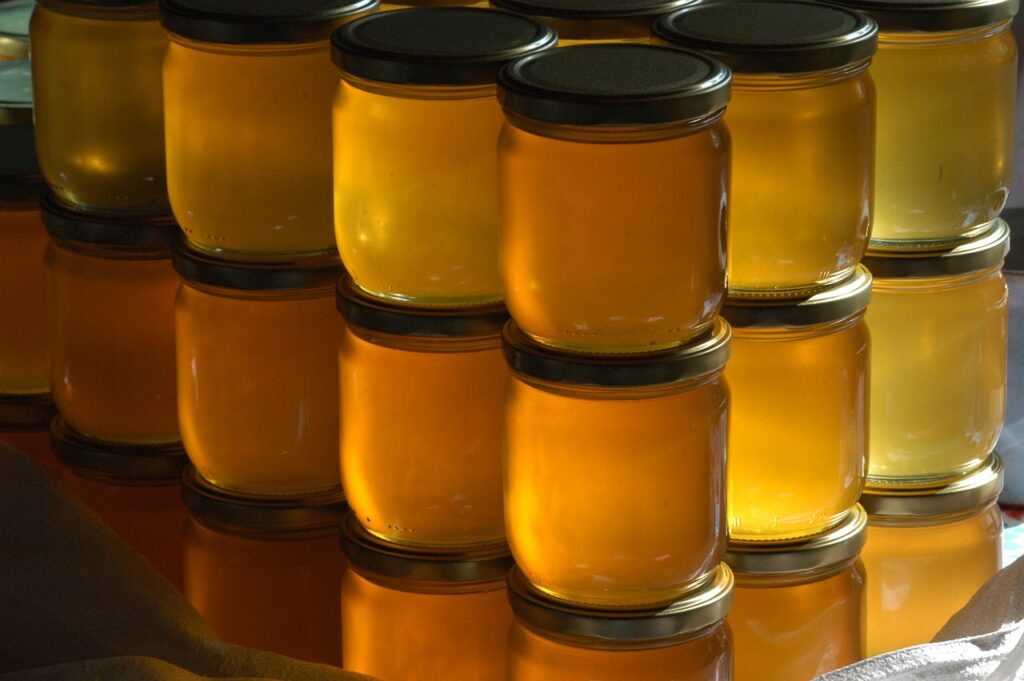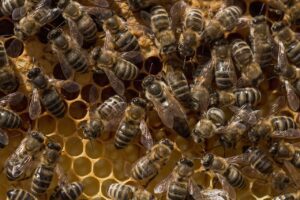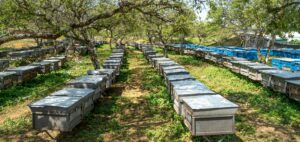Welcome to the wonderful world of beekeeping! You have found a comprehensive beginner’s guide to beekeeping with ample additional resources. Whether you’re captivated by the mesmerizing dance of bees, fascinated by the intricate workings of a hive, or simply eager to harvest your own honey, you’re in the right place. Beekeeping is a rewarding and fulfilling hobby that not only connects you with nature but also contributes to the health of our environment.
Table of Contents

Beginner’s Guide to Beekeeping
- If you are reading a beginner’s guide to beekeeping, it’s natural to have questions and feel a bit overwhelmed, but don’t worry—we’re here to guide you every step of the way. In this blog post, you’ll find all the essential information and tips you need to begin your beekeeping journey with confidence. So, let’s dive in and discover the joys of beekeeping together!
- Beekeeping offers numerous environmental benefits and personal satisfactions. Environmentally, bees play a crucial role in pollinating plants, which supports biodiversity and helps produce many of the fruits, vegetables, and nuts we rely on. By keeping bees, you contribute to maintaining healthy ecosystems and combating the decline of bee populations.
- Personally, beekeeping is incredibly rewarding. It provides a sense of accomplishment as you care for and grow your hive, and, of course, gives you the sweet reward of home-harvested honey. Plus, the peaceful, meditative nature of working with bees can be a great way to reduce stress and enjoy a fulfilling hobby.
Understanding Beekeeping
- What is Beekeeping? – Beekeeping, also known as apiculture, is the practice of maintaining and managing bee colonies, typically in man-made hives. The primary purpose of beekeeping is to produce honey, beeswax, and other bee products, as well as to support pollination for crops and gardens.
- Beekeeping also helps to sustain and increase bee populations, which are vital for ecological health and biodiversity. Whether pursued as a hobby, a business, or a way to contribute to environmental conservation, beekeeping is a fulfilling activity that connects people with nature and supports the health of our ecosystems.
- History of Beekeeping: Find a brief overview here of how beekeeping has evolved over the years.
- Types of Beekeeping: Beekeeping can be categorized into three main types: hobbyist, commercial, and urban beekeeping. Each type has distinct characteristics, goals, and practices. Find more details here.
Getting Started in Beekeeping
- Research: Read about the 6 important factors to learn about bees and beekeeping before starting here.
- Local Regulations: Many states and locales have different regulations for beekeeping. Be sure to look up the regulations in your area.
Essential Beekeeping Supplies for Beginners
Read Beginner Beekeeping Kit – 6 Essential Tips Beekeepers Should Know Before Buying if you would like to purchase a kit.
Beekeeping Suit: Importance of Protective Clothing
- Safety and Protection:
- Shields beekeepers from stings and potential allergens.
- Prevents direct contact with bee venom and irritants.
- Comfort and Confidence:
- Provides comfort during hive inspections and honey harvesting.
- Boosts confidence, especially for beginners, in handling bees.
- Read our article – Choosing the Right Beekeeping Suit: Exploring 4 Types for Safety and Comfort for more information.
Essential Equipment for Beekeeping

- Hive Tool:
- Used for prying apart hive components and scraping off propolis.
- Essential for inspecting and maintaining hive frames.
- Check out Choosing the Right Hive Tools: 7 Tips for Beekeepers.
- Smoker:
- Calms bees by releasing smoke, making them less defensive.
- Facilitates easier hive inspections and manipulations.
- Brush:
- Gently removes bees from frames without harming them.
- Helps maintain cleanliness during hive inspections.
- Check out 6 Essential Tips for Choosing the Perfect Beekeeper Brush for more information.
Bee Hives: Types and Their Pros and Cons
The Beehive Chronicles: 6 Types of Hives for Bee Keeping and Advanced Apiculture Practices
- Langstroth Hive:
- Pros: Standardized frame sizes, efficient honey production.
- Cons: Requires heavy lifting, complex management.
- Top Bar Hive:
- Pros: Simple design, natural comb development.
- Cons: Less honey production, limited expandability.
- Warre Hive:
- Pros: Natural beekeeping approach, minimal disturbance.
- Cons: Limited availability of equipment, less common in some regions.
Bee Colony: Acquiring Bees for Your Hive
- Buying Packages:
- Purchasing a queen and a group of worker bees in a screened box.
- Suitable for starting a new hive or replacing a lost colony.
- Nucs (Nucleus Colonies):
- Established mini colonies with a queen, workers, and brood frames.
- Provides a head start with a functioning bee community.
- Swarm Capture:
- Capturing a natural bee swarm.
- Requires experience and proper equipment, offers genetic diversity.
Setting Up Your Apiary
Advanced Techniques in Apiculture: 10 Pro Tips for Beekeepers
Location: Tips for Choosing the Right Location for Your Hives
- Sunlight and Shade:
- Select a location with ample morning sunlight and afternoon shade.
- Helps regulate hive temperature and activity levels.
- Wind Protection:
- Place hives in a sheltered area to protect them from strong winds.
- Prevents hive disturbance and maintains colony comfort.
- Accessibility:
- Ensure easy access for hive inspections, maintenance, and honey harvesting.
- Minimizes disruption to bees and beekeeper during routine tasks.
Hive Placement: How to Position Your Hives for Optimal Results
- Orientation:
- Face hive entrances towards the east or south.
- Maximizes exposure to sunlight and early morning warmth.
- Elevation:
- Place hives slightly elevated to prevent moisture buildup and flooding.
- Helps maintain hive cleanliness and health during wet weather.
- Spacing:
- Maintain adequate spacing between hives for airflow and bee foraging.
- Reduces competition and potential conflicts between colonies.
Initial Setup: Steps to Set Up the Hive and Introduce the Bees
- Assembling Equipment:
- Gather hive components, tools, and protective gear.
- Ensure everything is in place before starting the setup process.
- Installing Bees:
- Introduce bees into the hive using chosen method (package, nuc, swarm).
- Follow proper handling procedures to minimize stress and ensure safety.
- Monitoring and Adjustment:
- Regularly monitor hive activity and health post-installation.
- Make adjustments to hive setup or management based on observations and bee behavior.
Caring for Your Bees
Feeding Bees: When and What to Feed Your Bees
- Timing of Feeding:
- Provide supplementary feed during periods of nectar dearth or in early spring to stimulate colony growth.
- Monitor hive conditions and bee activity to determine when feeding is necessary.
- Types of Feed:
- Offer sugar syrup (1:1 or 2:1 ratio of sugar to water) as a carbohydrate source.
- Provide pollen substitute or patties to supplement protein intake, especially in early spring.
- Choosing Bee Feeders: 10 Proven Tips and How to Use Them
Inspecting the Hive: How to Properly Inspect a Hive and What to Look For
- Preparation:
- Wear protective gear, light smoker, and necessary tools before starting the inspection.
- Approach the hive calmly and avoid sudden movements to minimize disturbance.
- Inside the Hive:
- Queen Bees: 10 Tips for Beekeepers Locating the Queen Bee During Hive Inspections
- Sole egg-layer in the hive.
- Mates with drones to ensure genetic diversity.
- Releases pheromones that regulate hive behavior.
- We wrote about queens here – 6 Ways Queen Bees Influence Hive Behavior and Productivity
- Drone Bees:
- Male bees with the sole purpose of mating with the queen.
- Short lifespan focused on reproduction.
- Expelled from the hive during non-mating seasons.
- Read more at 5 Essential Roles of Honey Bee Drones Every Beekeeper Needs to Know
- Worker Bees:
- Female bees responsible for all hive activities.
- Roles include nursing larvae, foraging, and hive defense.
- Live for several weeks or months depending on the season.
- Find more information at Understanding the 4 Life Stages of a Honey Bee Worker: Insights for Beekeepers
- Brood Pattern:
- Check for a healthy brood pattern with eggs, larvae, and capped brood cells.
- Irregular patterns may indicate issues with the queen or hive health.
- Pests and Diseases:
- Look for signs of Varroa mites, hive beetles, or other pests on bees and in hive debris.
- Inspect for symptoms of diseases such as foulbrood, chalkbrood, or nosema.
- Queen Bees: 10 Tips for Beekeepers Locating the Queen Bee During Hive Inspections
Pest and Disease Management: Common Issues and How to Handle Them
For a more comprehensive overview read 8 Common Beehive Pests and Effective Prevention Tips for Beekeepers
- Varroa Mites:
- Implement integrated pest management (IPM) strategies, such as using screened bottom boards and natural treatments.
- Monitor mite levels regularly and treat as necessary to prevent colony decline.
- We wrote about Varroa mites in more detail in 10 Effective Ways to Combat Varroa Mites in Your Beehive.
- Hive Beetles:
- Reduce beetle populations by maintaining strong colonies and ensuring proper hive ventilation.
- Use beetle traps or oil trays to trap and control beetle numbers.
- Please read 12 Tips for Managing and Preventing Hive Beetles in Your Apiary if you would like more information.
- Ants – 7 Ways Ants Threaten Beehives: Impact and Ant Prevention Tips
- Wax Moths – Understanding Wax Moths: 7 Key Facts Every Beekeeper Should Know
- Diseases:
- Foulbrood (European Foulbrood):
- Recognize foulbrood symptoms and consult local regulations for treatment options.
- Implement biosecurity measures to prevent disease spread within apiaries.
- American Foulbrood:
- Identify symptoms of American foulbrood, a highly contagious bacterial disease affecting brood larvae.
- Follow strict quarantine and destruction protocols for infected hives to prevent disease spread.
- Foulbrood (European Foulbrood):
Harvesting Honey

The Perfect Honey Extractor – 8 Expert Tips for Beekeepers
When to Harvest: Signs That It’s Time to Harvest Honey
- Capped Honey Cells:
- Bees cap honey cells with wax when the honey is sufficiently ripe and moisture content is low.
- Look for uniformly capped cells across the frames as a primary indicator.
- Viscosity and Color:
- Honey should be thick and viscous, not watery, when tested by tilting the frame.
- Color may vary based on floral sources but should generally be golden or amber.
- Smell and Taste:
- Mature honey has a distinct floral aroma and a sweet, pleasant taste.
- Beeswax cappings should be firm and intact when gently scraped.
Harvesting Process: Step-by-Step Guide on How to Extract Honey
- Prepare Equipment:
- Gather honey extraction equipment, including a bee brush, uncapping knife, and extractor.
- Ensure jars and containers for storing honey are clean and dry.
- Uncapping Frames:
- Use an uncapping knife to remove beeswax cappings from honey cells.
- Uncap frames over a clean, smooth surface to collect wax for processing.
- Extracting Honey:
- Place uncapped frames into an extractor and spin to extract honey from comb cells.
- Filter honey through a mesh sieve or cheesecloth to remove impurities and wax particles.
- Bottling Honey:
- Fill clean, dry jars with extracted honey and seal tightly to preserve freshness.
- Label jars with harvest date and floral source if known for traceability.
Storing Honey: Best Practices for Storing Honey
A Quality Honey Pot: 6 Essential Features to Look for
- Container Selection:
- Use glass or food-grade plastic containers with tight-fitting lids to store honey.
- Avoid metal containers as they can affect honey flavor and quality over time.
- Storage Conditions:
- Store honey in a cool, dry place away from direct sunlight and heat sources.
- Optimal storage temperature is between 50-70°F (10-21°C) to maintain honey’s quality.
- Longevity and Crystallization:
- Honey does not spoil, but it may crystallize over time.
- To liquefy crystallized honey, gently warm the jar in a bowl of warm water (not exceeding 100°F or 40°C).
Beekeeping Tips and Best Practices
Seasonal Management: What Tasks to Perform During Different Seasons
- Spring:
- Inspect and Feed: Conduct hive inspections to assess colony strength and queen health. Provide supplemental feeding if necessary to stimulate brood production.
- Swarm Prevention: Manage hive overcrowding by splitting colonies or adding supers to prevent swarming.
- Queen Management: Monitor queen performance and consider requeening if necessary.
- Summer:
- Monitor Honey Flow: Regularly check honey supers for full frames and harvest as needed.
- Pest Control: Monitor and manage pest levels, such as Varroa mites, during peak activity.
- Water Supply: Ensure bees have access to clean water sources near the hive to prevent dehydration.
- Fall:
- Harvesting: Complete honey harvest before temperatures drop too low.
- Winter Preparation: Inspect hives for adequate winter stores. Provide supplemental feeding if honey reserves are low.
- Protecting from Elements: Protect hives from harsh weather conditions by wrapping or insulating as needed.
Safety Tips: Ensuring Safety for Both the Beekeeper and the Bees
- Protective Gear:
- Always wear appropriate protective clothing, including a beekeeping suit, veil, gloves, and sturdy boots.
- Ensure clothing is in good condition without holes or gaps where bees could enter.
- Use of Tools: Choosing the Right Hive Tools: 7 Tips for Beekeepers
- Handle beekeeping tools, such as smokers and hive tools, with care to avoid injury to yourself and harm to bees.
- Keep tools clean and well-maintained to prevent cross-contamination between hives.
- Bee Behavior Awareness:
- Learn to read bee behavior cues, such as buzzing intensity and defensive postures, to gauge hive temperament.
- Approach hives calmly and avoid sudden movements to minimize disturbance and reduce stinging incidents.
Continuous Learning: Importance of Staying Updated with Beekeeping Knowledge
- Research and Education:
- Stay informed about current beekeeping practices, advancements in hive management, and pest and disease control methods.
- Attend workshops, seminars, or join beekeeping associations to network with other beekeepers and exchange knowledge.
- Adaptation to Changes:
- Be adaptable to changing environmental conditions, emerging pests, and diseases affecting bee health.
- Implement sustainable beekeeping practices that promote colony resilience and biodiversity conservation.
- Record Keeping:
- Maintain detailed records of hive inspections, honey harvests, and any treatments applied to monitor hive health and productivity.
- Use records to identify trends or patterns that may impact future management decisions.
Other Resources
- The USDA has an excellent pdf here.
- Check out Understanding the 4 Life Stages of a Honey Bee Worker: Insights for Beekeepers if you want to know more about bees.
Conclusion
Thank you for reading our Beginner’s Guide to Beekeeping. Embarking on the journey of beekeeping is not just about harvesting honey; it’s a profound connection with nature and a commitment to supporting our ecosystem. By following these 8 steps, you’ve laid a solid foundation for success in beekeeping:
- Understanding Bee Behavior: Appreciating the intricacies of hive dynamics.
- Choosing Equipment: Selecting the right tools for hive management.
- Selecting a Hive Location: Optimal placement for hive health and productivity.
- Acquiring Bees: Methods for obtaining bees and introducing them to their new home.
- Managing Hive Health: Regular inspections and disease prevention.
- Harvesting Honey: When and how to collect your sweet rewards.
- Safety Measures: Protecting yourself and your bees during hive interactions.
- Continuous Learning: Staying updated with best practices and new developments in beekeeping.
As you continue your journey, remember the importance of patience, observation, and learning from each hive’s unique characteristics. Whether for personal enjoyment, environmental stewardship, or community impact, beekeeping offers countless rewards. Embrace the journey ahead, and may your beekeeping experience be both enriching and fulfilling.



